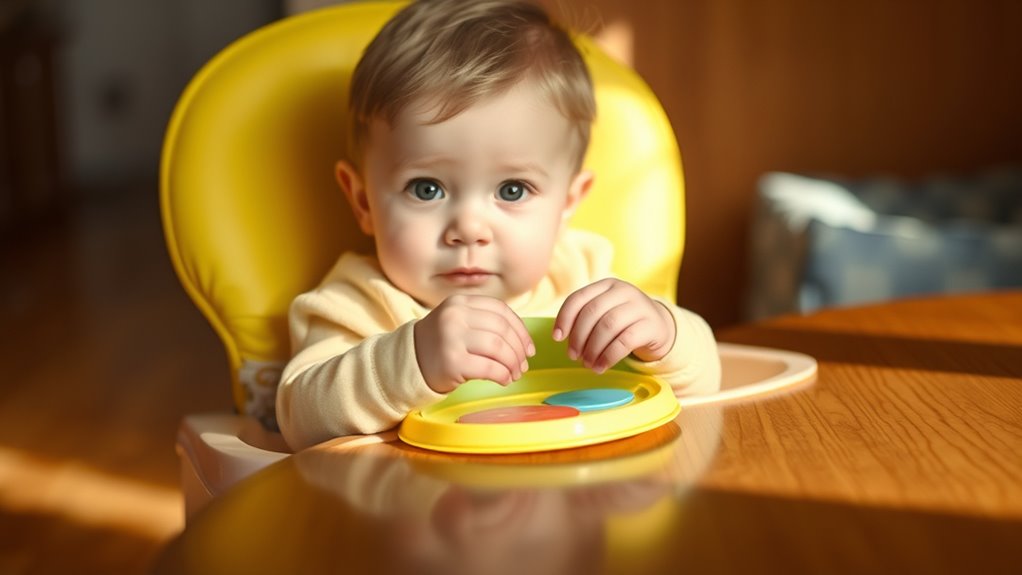When shifting from a high chair to a table, be patient and gentle as your child adjusts. Involve them in choosing a supportive, comfortable seat and start with short meal periods to build familiarity. Keep routines consistent and offer plenty of praise to encourage confidence. Remember, every child adapts at their own pace, so stay positive and supportive throughout. If you keep going, you’ll discover effective strategies to make this transition smoother for your child.
Key Takeaways
- Gradually introduce the table setting, starting with short meals at the new seat to build familiarity.
- Involve the child in choosing their new seat or cushions to foster ownership and comfort.
- Ensure the new seating provides proper support, stability, and is appropriately sized for safety.
- Maintain consistent routines to reduce anxiety and help the child adapt smoothly.
- Use positive reinforcement and patience to encourage the child’s confidence during the transition.

Switching your child from a high chair to a regular table is an exciting milestone that encourages independence and social skills. However, don’t expect the changeover to be immediate or seamless. There’s usually an adjustment period as your child gets used to new seating options and the different environment. During this time, patience is key. Your child might be wobbly, unsure, or even resistant, but with gentle guidance, they’ll adapt over time. It’s important to recognize that every child is different; some may embrace the change quickly, while others need a little more time to feel comfortable at a standard table.
One of the first steps is to explore different seating options. You want to guarantee your child’s new seat provides proper support and fits well at the table. High chairs often have a built-in tray, which helps contain messes and keeps your child secure, but at a regular table, you’ll need to contemplate booster seats, small chairs, or specialized toddler chairs. Booster seats with harnesses can be a great choice because they raise your child to the right height and keep them stable. Small, adjustable chairs allow for growth and can be moved easily, giving your child a sense of independence while maintaining safety. Whichever option you choose, make sure it’s stable, secure, and at a comfortable height for your child to reach the table and participate comfortably.
As you switch to these new seating arrangements, involve your child in the process. Let them choose a favorite seat or pick out a fun cushion. This involvement helps foster a sense of ownership and excitement about the change. Keep the transition gradual; start by having meals at the new seat for short periods, then slowly increase the duration as your child becomes more comfortable. Use positive reinforcement—praise, smiles, and encouragement—to reinforce their efforts and successes. Keep routines consistent, so your child knows what to expect during meal times, which helps reduce anxiety and resistance.
Frequently Asked Questions
When Is the Best Age to Transition to a Table?
You should consider shifting your child to a table around 18 to 24 months when they’re reaching key developmental milestones like sitting steadily and eating independently. This change helps establish consistent mealtime routines and promotes independence. Watch for signs they’re comfortable sitting through meals, and gradually introduce the table to make the switch smooth. Remember, every child develops at their own pace, so adjust based on their confidence and skills.
How Do I Encourage My Child to Sit at the Table?
To encourage your child to sit at the table, establish consistent mealtime routines that make sitting down inviting and predictable. Use encouraging words and praise when they try to sit independently, fostering their confidence. Offer small, manageable responsibilities like helping set the table to promote independence. Keep mealtime positive and distraction-free, and gradually increase their time at the table, helping them feel comfortable and enthusiastic to join family meals.
What Safety Precautions Should I Take During Transition?
You should childproof the area by securing furniture, removing sharp objects, and using outlet covers. Always supervise your child closely during the changeover, and consider safety seat options like a booster seat with a harness for added security. Check that the table and chairs are sturdy and at the right height, and make certain the floor is slip-resistant. These childproofing tips help keep your child safe as they learn to sit at the table independently.
How Can I Make the Table Environment More Inviting?
Imagine transforming your table into a magical kingdom of comfort and fun! You can make it inviting by carefully choosing a cheerful table setting with colorful placemats and fun dishware. Arrange seating arrangements that encourage conversation and closeness, like a cozy circle or a family-style layout. Add soft lighting or playful decorations, creating an environment where your little one feels excited to sit, eat, and grow with you every mealtime.
Are There Specific Types of Tables Suitable for Toddlers?
Yes, toddler-friendly tables typically feature durable table materials like plastic or laminated wood, which are easy to clean and withstand spills. Look for tables with chair ergonomics designed for small children, offering appropriate height and comfortable seating. This guarantees your toddler can sit comfortably and independently, promoting good posture and ease of use. Choosing the right table with suitable materials and ergonomic chairs makes mealtime safer, more enjoyable, and encourages independence.
Conclusion
Moving your child from a high chair to the table is a big milestone that fosters independence and social skills. Keep in mind, research shows that children who dine at the table with family tend to develop better eating habits and stronger communication skills. By encouraging this shift, you’re helping your little one build confidence and healthy routines that last a lifetime. Embrace the change—it’s an exciting step toward their growing independence and your family’s bonding moments.









